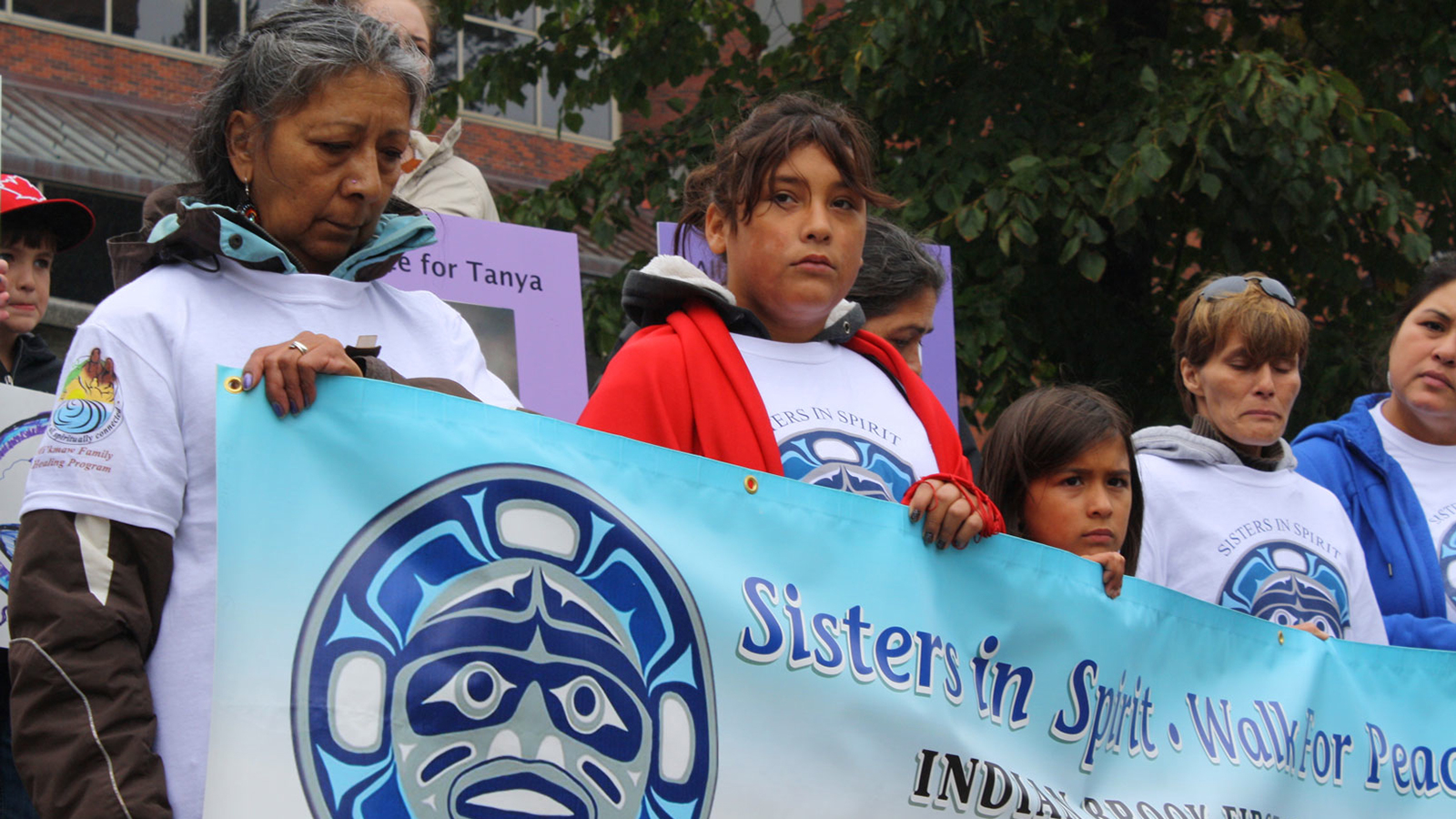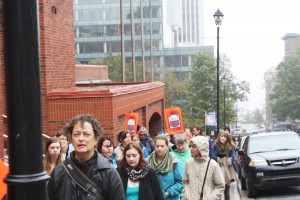Native women silent no more

caption
Family, friends and supporters gathered to mourn missing and murdered aboriginal women in Halifax in October, 2014.National media improves coverage of missing and murdered aboriginal women
“Missing and murdered,” the old man breathed into the megaphone. “Two words a mother never wants to hear.”
Native Elder Tom Christmas stood on the steps of Grand Parade on a rainy October day in Halifax. About 20 women stood behind him, holding pictures of lost daughters, sisters and friends. The Sisters in Spirit national vigil for missing and murdered aboriginal women had begun.
On some of the banners and signs was a face familiar to the city: Loretta Saunders.
The 26-year-old Inuk woman from Labrador was studying at Saint Mary’s University in Halifax when she went missing. She was preparing a thesis on missing and murdered aboriginal women. On February 26, 2014, she tragically became a part of that thesis.

caption
Dozens showed up in the rain to show their support for the cause.“My story isn’t unique,” Saunders wrote in her thesis proposal. “Thousands of girls are exposed to the exact same experiences that I couldn’t even fathom wishing upon another human being.”
Before Saunders’ case became national news, deaths and disappearances of indigenous women rarely made the front page. In 2014, with her death, something changed. National coverage of aboriginal women skyrocketed – with the CBC, CTV, the Globe and Mail and other media treating aboriginal stories as a top priority.
Ten years ago Amnesty International issued a condemning report against Canada’s authorities. The human rights organization said the nation’s government and police failed to protect aboriginal women from violence and murder. That same year CBC’s The National covered only one disappearance of an aboriginal female. In 2004, 45 aboriginal women were murdered.
After thirty years of sporadic coverage these women’s stories are finally being told. Saunders’ gruesome murder shocked the nation.
Before her death, Saunders had already made a lasting impression on her academic advisor, Darryl Leroux. The assistant professor of sociology and criminology at Saint Mary’s worked extensively with Saunders on her thesis for six months before her death. Leroux said Saunders was determined to share the stories of aboriginal women who were mistreated.
“When an aboriginal woman goes missing, the assumption is that she’s involved in some sort of illicit activity, whether it’s prostitution or having some sort of addiction,” said Leroux. “Loretta really wanted to give a voice to those women who just didn’t have one.”
Saunders was portrayed in the media as a non-stereotypical aboriginal woman: one looking at a successful future. The murder of this young, educated woman had a simple message: this can happen to anyone.
Cheryl Maloney, President of the Nova Scotia Native Women’s Association, spoke with Saunders about her thesis a couple of months before her death. It wasn’t until Maloney was helping to put up missing posters for Saunders that she realized it was the same woman.
“No… It can’t be,” Maloney thought.
Maloney said from that moment she had to become the voice for this young woman. She and Leroux became the public face for Saunders and her family, responding to calls from various media outlets. Leroux said he had a dozen calls and messages within an hour of being told Saunders’ body had been found. The young woman’s murder turned into a media frenzy.
The Globe and Mail’s Atlantic Bureau Chief, Jane Taber, says she didn’t have to go far to find Saunders’ story; it came to her. Taber heard that people all over the city were putting up posters for this missing woman.
“The difference about this case,” Taber said, “which is unfortunate for other women, is that the police really took this seriously… Is it because she doesn’t look native? Is it because she has a university education?”
Saunders’ case wrapped up quickly, as her body was found two weeks after she went missing. She had already been headlining the news when her body was found. Taber says the quick coverage of her murder, along with the irony of her thesis topic, made Saunders a household name is local news.
“This really says something about (journalists) and how we cover things,” Taber said. “It also says something about society.”
Maloney saw first hand how the Saunders case affected not only Nova Scotia but the rest of the country. She planned a vigil for Saunders on Parliament Hill a couple of months after her death. Maloney didn’t expect word to spread like it did. Hundreds gathered in the capital city for a woman many of them didn’t know. Maloney says her phone “never stopped ringing” and she was getting asked for interviews as far away as the United Kingdom.
“That’s when it hit me that people cared,” Maloney said. “The readers and listeners wanted to know more. Their hearts were broken just like all of ours.”
In 2013, the RCMP conducted a nationwide study on the murders and disappearances of aboriginal women, in alliance with the national grassroots organization Sisters in Spirit.
The results were startling.
The study showed aboriginal women, while representing less than 5 per cent of the female population in Canada, accounted for roughly 16 per cent of all female homicides from 1980 through 2012. During this time aboriginal female homicides jumped from nine per cent of the female population in 1980 to 23 per cent in 2012. In total the RCMP documented 1,017 murder victims and 164 missing aboriginal women in the past 32 years.
Three years prior to the study Kristen Gilchrist, then a PhD student at Carleton University, demonstrated clear evidence that aboriginal women are treated as second-class citizens. In her article Newsworthy Victims, Gilchrist compared local media coverage of the murders of three white women in Ontario to three aboriginal women in Saskatchewan. Gilchrist found that the white women were covered six times more often in local press then the aboriginal women. Gilchrist noted in her article that while the Saskatchewan newspapers are smaller than the Ontario newspapers “they also have less local news to cover”, and argued that local murders would receive more coverage.
Gilchrist found a strong correlation between police attention and media coverage. She said aboriginal women are denied a “status and legitimacy” given to many white victims by the media. Gilchrist’s analysis concluded that aboriginal women were at the bottom of the hierarchy for media coverage. She said these women “regardless of occupation, personal achievement, appearance or circumstances, are ignored.”
Loretta Saunders falls into Gilchrist’s definition of a newsworthy victim, even though she is aboriginal. At first glance, Saunders did not look like a typical aboriginal woman, as she had fair skin and light hair. She was a university student with dreams of being a lawyer. She was also pregnant when she was murdered. All of these factors arguably made her newsworthy, and explain why the national media was attracted to Saunders’ story.
Paul Barnsley is no stranger to the stories of missing and murdered aboriginal women; he stumbled into the beat 14 years ago. A former writer for the Windspeaker, an aboriginal affairs magazine in Calgary, Barnsley received a call in 2002 from a young aboriginal woman in a halfway home. The woman said she had come across a website where a man was posting pictures of drugged women in provocative poses.
Many of the women were people she knew.
Barnsley investigated the story and found a more startling revelation: the Calgary police turned a blind eye to cases involving aboriginal women whom they considered to be “high-risk”. In 2002, Barnsley asked a Calgary police officer if the man who created the website was going to be investigated. Barnsley says the officer replied “the hard-ass attitude is ‘You took your clothes off, lady, for this guy for whatever reason.’ This doesn’t fall within the police mandate. It’s a civil matter.”
Barnsley is now executive producer of the Aboriginal People’s Television Network program APTN Investigates, in which journalists cover controversial aboriginal stories that don’t usually make national mainstream media headlines. He said many factors have contributed to the spike in coverage of aboriginal women, including pressure from grassroots organizations.
“This was a problem a long time ago,” he said. “And now the big media organizations think this issue deserves some of their attention. All I can say is good, but where ya been?”
Barnsley doesn’t believe much has changed institutionally. He said although police involved in aboriginal cases might not outright say that these women are not worth their time, he believes some still think like the officer 14 years ago. Barnsley believes there is a “serious racism problem” in our society, one often ignored by government, authorities and the media.
“When a little blonde girl goes missing everything stops. But there’s more than a thousand missing and murdered aboriginal women and everything hasn’t stopped.”
-Paul Barnsley, Investigative Journalist, APTN
Gladys Radek had the same issues with the police investigation of her niece’s disappearance on Highway 16, also known as the Highway of Tears, in northern British Columbia. Tamara Chipman is one of 18 victims that police believe have been murdered or disappeared along the highway. Walk4Justice, Radek’s grassroots organization, estimates the number of missing and murdered women is in the 40s.
Chipman went missing in 2005 while hitchhiking. Radek said police quickly dismissed her case. Three years prior, however, Nicole Hoar, a white woman from Red Deer, went missing. Radek believes she saw racism not only in the police investigation of Hoar’s case but also the media coverage. Hoar’s was the first Highway of Tears case to get picked up by the Globe and Mail.
Radek started Walk4Justice in 2006 after a symposium was held for the families of Highway of Tears victims. Radek, who has a prosthetic leg from a motorcycle accident, walked a 800 km. stretch of the highway to promote awareness against the mistreatment of aboriginal women.
“We’re all treated as high-risk behaviour victims,” said Radek. “I hate that term, high-risk, because that could mean anything from prostitution to hitchhiking.”
Holly Jarrett contributed to her cousin’s legacy by refusing to let Loretta Saunders’ name die with her. Jarrett started the national #AmINext social media campaign in memory of Saunders. Jarrett, who lives in Cornwall, Ontario, was unable to make it home for her cousin’s funeral. She started the campaign to help with the healing process. The simple slogan told a haunting message: every aboriginal woman in this country is at risk.
“Aboriginal women (are now) being open about their struggles,” said Jarrett. “Everyone needs to know what’s happening in the lives of these women who keep going missing and getting murdered.”
Jarrett’s campaign has been reported by CBC Radio, the Globe and Mail, and other Canadian media outlets. She said she has been contacted almost every day since she started the campaign in September, 2014. Although Jarrett is still mourning the death of her cousin, she’s determined to force government to recognize this urgent issue.
“Fear is what keeps me moving forward,” she said. “I don’t want my daughter to be a mother who has to worry about her children like I do.”
Back in Halifax, Saunders’ face has not been forgotten. Her photo was carried by many people during the Sisters in Spirit Vigil. A young woman fought back tears during the Mi’kmaq Honour Drum Song while clutching Saunders’ picture in her hands. “No More Stolen Sisters” read the words above Saunders’ smiling face.
Saunders’ rise to national fame as an aboriginal victim has many factors. The triumph here, though, is that she broke the silence of more than a thousand voiceless women. Before her death, Saunders was already vocal about these struggles, as shown in her thesis work. After her body was found, media started to pay attention.
“It’s not that indigenous women haven’t been vocal in the past,” said Darryl Leroux. “It’s just that their voices are finally being heard.”
https://youtube.com/watch?v=KPQ9Sj-471Q
Editor's Note
This story was reported and written by Oct. 17, 2014.

